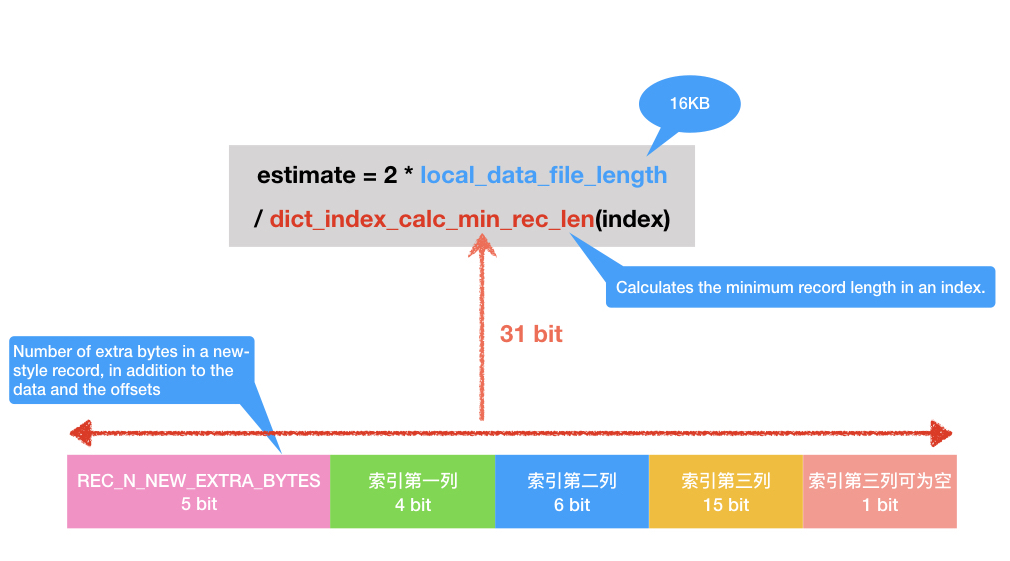一次 group by + order by 性能优化分析
来源:SegmentFault
时间:2023-02-16 15:34:00 397浏览 收藏
数据库小白一枚,正在不断学习积累知识,现将学习到的知识记录一下,也是将我的所得分享给大家!而今天这篇文章《一次 group by + order by 性能优化分析》带大家来了解一下一次 group by + order by 性能优化分析,希望对大家的知识积累有所帮助,从而弥补自己的不足,助力实战开发!
原文:我的个人博客 https://mengkang.net/1302.html
工作了两三年,技术停滞不前,迷茫没有方向,不如看下我的直播 PHP 进阶之路 (金三银四跳槽必考,一般人我不告诉他)
最近通过一个日志表做排行的时候发现特别卡,最后问题得到了解决,梳理一些索引和MySQL执行过程的经验,但是最后还是有5个谜题没解开,希望大家帮忙解答下
主要包含如下知识点
- 用数据说话证明慢日志的扫描行数到底是如何统计出来的
- 从 group by 执行原理找出优化方案
- 排序的实现细节
- gdb 源码调试
背景
需要分别统计本月、本周被访问的文章的 TOP10。日志表如下
CREATE TABLE `article_rank` ( `id` int(11) unsigned NOT NULL AUTO_INCREMENT, `aid` int(11) unsigned NOT NULL, `pv` int(11) unsigned NOT NULL DEFAULT '1', `day` int(11) NOT NULL COMMENT '日期 例如 20171016', PRIMARY KEY (`id`), KEY `idx_day_aid_pv` (`day`,`aid`,`pv`), KEY `idx_aid_day_pv` (`aid`,`day`,`pv`) ) ENGINE=InnoDB DEFAULT CHARSET=utf8
准备工作
为了能够清晰的验证自己的一些猜想,在虚拟机里安装了一个 debug 版的 mysql,然后开启了慢日志收集,用于统计扫描行数
安装
- 下载源码
- 编译安装
- 创建 mysql 用户
- 初始化数据库
- 初始化 mysql 配置文件
- 修改密码
如果你兴趣,具体可以参考我的博客,一步步安装 https://mengkang.net/1335.html
开启慢日志
编辑配置文件,在
slow_query_log=1 slow_query_log_file=xxx long_query_time=0 log_queries_not_using_indexes=1
性能分析
发现问题
假如我需要查询
mysql> explain select aid,sum(pv) as num from article_rank where day>=20181220 and day
系统默认会走的索引是
# Time: 2019-03-17T03:02:27.984091Z # User@Host: root[root] @ localhost [] Id: 6 # Query_time: 56.959484 Lock_time: 0.000195 Rows_sent: 10 Rows_examined: 1337315 SET timestamp=1552791747; select aid,sum(pv) as num from article_rank where day>=20181220 and day
为什么扫描行数是 1337315
我们查询两个数据,一个是满足条件的行数,一个是
mysql> select count(*) from article_rank where day>=20181220 and day select count(distinct aid) from article_rank where day>=20181220 and day
发现
# 开启 optimizer_trace set optimizer_trace='enabled=on'; # 执行 sql select aid,sum(pv) as num from article_rank where day>=20181220 and day
摘取里面最后的执行结果如下
{
"join_execution": {
"select#": 1,
"steps": [
{
"creating_tmp_table": {
"tmp_table_info": {
"table": "intermediate_tmp_table",
"row_length": 20,
"key_length": 4,
"unique_constraint": false,
"location": "memory (heap)",
"row_limit_estimate": 838860
}
}
},
{
"converting_tmp_table_to_ondisk": {
"cause": "memory_table_size_exceeded",
"tmp_table_info": {
"table": "intermediate_tmp_table",
"row_length": 20,
"key_length": 4,
"unique_constraint": false,
"location": "disk (InnoDB)",
"record_format": "fixed"
}
}
},
{
"filesort_information": [
{
"direction": "desc",
"table": "intermediate_tmp_table",
"field": "num"
}
],
"filesort_priority_queue_optimization": {
"limit": 10,
"rows_estimate": 1057,
"row_size": 36,
"memory_available": 262144,
"chosen": true
},
"filesort_execution": [
],
"filesort_summary": {
"rows": 11,
"examined_rows": 552203,
"number_of_tmp_files": 0,
"sort_buffer_size": 488,
"sort_mode": "<sort_key additional_fields>"
}
}
]
}
}</sort_key>
分析临时表字段
mysql gdb 调试更多细节 https://mengkang.net/1336.html
通过
Breakpoint 1, trace_tmp_table (trace=0x7eff94003088, table=0x7eff94937200) at /root/newdb/mysql-server/sql/sql_tmp_table.cc:2306
warning: Source file is more recent than executable.
2306 trace_tmp.add("row_length",table->s->reclength).
(gdb) p table->s->reclength
$1 = 20
(gdb) p table->s->fields
$2 = 2
(gdb) p (*(table->field+0))->field_name
$3 = 0x7eff94010b0c "aid"
(gdb) p (*(table->field+1))->field_name
$4 = 0x7eff94007518 "num"
(gdb) p (*(table->field+0))->row_pack_length()
$5 = 4
(gdb) p (*(table->field+1))->row_pack_length()
$6 = 15
(gdb) p (*(table->field+0))->type()
$7 = MYSQL_TYPE_LONG
(gdb) p (*(table->field+1))->type()
$8 = MYSQL_TYPE_NEWDECIMAL
(gdb)
通过上面的打印,确认了字段类型,一个
# Query_time: 4.406927 Lock_time: 0.000200 Rows_sent: 10 Rows_examined: 1337315 SET timestamp=1552791804; select aid,sum(pv) as num from article_rank force index(idx_aid_day_pv) where day>=20181220 and day
扫描行数都是
mysql> explain select aid,sum(pv) as num from article_rank force index(idx_day_aid_pv) where day>=20181220 and day
注意我上面使用了
mysql> explain select aid,sum(pv) as num from article_rank force index(idx_aid_day_pv) where day>=20181220 and day
查看 optimizer trace 信息
# 开启optimizer_trace set optimizer_trace='enabled=on'; # 执行 sql select aid,sum(pv) as num from article_rank force index(idx_aid_day_pv) where day>=20181220 and day
摘取里面最后的执行结果如下
{
"join_execution": {
"select#": 1,
"steps": [
{
"creating_tmp_table": {
"tmp_table_info": {
"table": "intermediate_tmp_table",
"row_length": 20,
"key_length": 0,
"unique_constraint": false,
"location": "memory (heap)",
"row_limit_estimate": 838860
}
}
},
{
"filesort_information": [
{
"direction": "desc",
"table": "intermediate_tmp_table",
"field": "num"
}
],
"filesort_priority_queue_optimization": {
"limit": 10,
"rows_estimate": 552213,
"row_size": 24,
"memory_available": 262144,
"chosen": true
},
"filesort_execution": [
],
"filesort_summary": {
"rows": 11,
"examined_rows": 552203,
"number_of_tmp_files": 0,
"sort_buffer_size": 352,
"sort_mode": "<sort_key rowid>"
}
}
]
}
}</sort_key>
执行流程如下
- 创建一张临时表,临时表上有两个字段,
drop procedure if exists idata; delimiter ;; create procedure idata() begin declare i int; declare aid int; declare pv int; declare post_day int; set i=1; while(i
# Query_time: 9.151270 Lock_time: 0.000508 Rows_sent: 10 Rows_examined: 2122417 SET timestamp=1552889936; select aid,sum(pv) as num from article_rank force index(idx_aid_day_pv) where day>=20181220 and day
这里扫描行数
mysql> show global variables like '%table_size'; +---------------------+----------+ | Variable_name | Value | +---------------------+----------+ | max_heap_table_size | 16777216 | | tmp_table_size | 16777216 | +---------------------+----------+
https://dev.mysql.com/doc/ref...
https://dev.mysql.com/doc/ref...max_heap_table_size
This variable sets the maximum size to which user-created MEMORY tables are permitted to grow. The value of the variable is used to calculate MEMORY table MAX_ROWS values. Setting this variable has no effect on any existing MEMORY table, unless the table is re-created with a statement such as CREATE TABLE or altered with ALTER TABLE or TRUNCATE TABLE. A server restart also sets the maximum size of existing MEMORY tables to the global max_heap_table_size value.tmp_table_size
The maximum size of internal in-memory temporary tables. This variable does not apply to user-created MEMORY tables.
The actual limit is determined from whichever of the values of tmp_table_size and max_heap_table_size is smaller. If an in-memory temporary table exceeds the limit, MySQL automatically converts it to an on-disk temporary table. The internal_tmp_disk_storage_engine option defines the storage engine used for on-disk temporary tables.也就是说这里临时表的限制是
set tmp_table_size=33554432; set max_heap_table_size=33554432;
# Query_time: 5.910553 Lock_time: 0.000210 Rows_sent: 10 Rows_examined: 1337315 SET timestamp=1552803869; select aid,sum(pv) as num from article_rank where day>=20181220 and day
方案3 使用 SQL_BIG_RESULT 优化
告诉优化器,查询结果比较多,临时表直接走磁盘存储。
# Query_time: 6.144315 Lock_time: 0.000183 Rows_sent: 10 Rows_examined: 2122417 SET timestamp=1552802804; select SQL_BIG_RESULT aid,sum(pv) as num from article_rank where day>=20181220 and day
扫描行数是
# SQL1 select aid,sum(pv) as num from article_rank where day>=20181220 and day=20181220 and day
- SQL1 执行过程中,使用的是全字段排序最后不需要回表为什么总扫描行数还要加上10才对得上?
- SQL1 与 SQL2
group by
之后得到的行数都是552203
,为什么会出现 SQL1 内存不够,里面还有哪些细节呢? - trace 信息里的
creating_tmp_table.tmp_table_info.row_limit_estimate
都是838860
;计算由来是临时表的内存限制大小16MB
,而一行需要占的空间是20字节,那么最多只能容纳floor(16777216/20) = 838860
行,而实际我们需要放入临时表的行数是785102
。为什么呢? - SQL1 使用
SQL_BIG_RESULT
优化之后,原始表需要扫描的行数会乘以2,背后逻辑是什么呢?为什么仅仅是不再尝试往内存临时表里写入这一步会相差10多倍的性能? - 通过源码看到 trace 信息里面很多扫描行数都不是实际的行数,既然是实际执行,为什么 trace 信息里不输出真实的扫描行数和容量等呢,比如
filesort_priority_queue_optimization.rows_estimate
在SQL1中的扫描行数我通过gdb看到计算规则如附录图 1 - 有没有工具能够统计 SQL 执行过程中的 I/O 次数?
附录

好了,本文到此结束,带大家了解了《一次 group by + order by 性能优化分析》,希望本文对你有所帮助!关注golang学习网公众号,给大家分享更多数据库知识!
-
499 收藏
-
244 收藏
-
235 收藏
-
157 收藏
-
101 收藏
-
271 收藏
-
338 收藏
-
419 收藏
-
119 收藏
-
127 收藏
-
137 收藏
-
473 收藏
-
140 收藏
-
252 收藏
-
434 收藏
-
233 收藏
-
385 收藏
-

- 前端进阶之JavaScript设计模式
- 设计模式是开发人员在软件开发过程中面临一般问题时的解决方案,代表了最佳的实践。本课程的主打内容包括JS常见设计模式以及具体应用场景,打造一站式知识长龙服务,适合有JS基础的同学学习。
- 立即学习 543次学习
-

- GO语言核心编程课程
- 本课程采用真实案例,全面具体可落地,从理论到实践,一步一步将GO核心编程技术、编程思想、底层实现融会贯通,使学习者贴近时代脉搏,做IT互联网时代的弄潮儿。
- 立即学习 516次学习
-

- 简单聊聊mysql8与网络通信
- 如有问题加微信:Le-studyg;在课程中,我们将首先介绍MySQL8的新特性,包括性能优化、安全增强、新数据类型等,帮助学生快速熟悉MySQL8的最新功能。接着,我们将深入解析MySQL的网络通信机制,包括协议、连接管理、数据传输等,让
- 立即学习 500次学习
-

- JavaScript正则表达式基础与实战
- 在任何一门编程语言中,正则表达式,都是一项重要的知识,它提供了高效的字符串匹配与捕获机制,可以极大的简化程序设计。
- 立即学习 487次学习
-

- 从零制作响应式网站—Grid布局
- 本系列教程将展示从零制作一个假想的网络科技公司官网,分为导航,轮播,关于我们,成功案例,服务流程,团队介绍,数据部分,公司动态,底部信息等内容区块。网站整体采用CSSGrid布局,支持响应式,有流畅过渡和展现动画。
- 立即学习 485次学习
